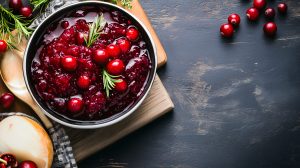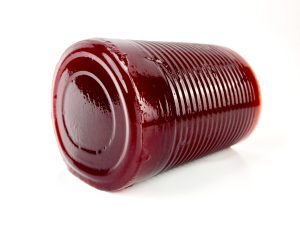 What do Dwight D. Eisenhower, Richard Nixon, JFK, Rachel Carson, Bill Clinton, pesticides and cranberries have to do with one another? How am I going to navigate such controversial inflammatory topics? Which is better, canned or fresh cranberries? Read on to get a little Pesticide History: Thanksgiving Cranberry Scare!
What do Dwight D. Eisenhower, Richard Nixon, JFK, Rachel Carson, Bill Clinton, pesticides and cranberries have to do with one another? How am I going to navigate such controversial inflammatory topics? Which is better, canned or fresh cranberries? Read on to get a little Pesticide History: Thanksgiving Cranberry Scare!
I promise I won’t get controversial; I love cranberries in whatever form they take! Who can forget the viral video of a gentleman soothing his terrible day and brutal commute to work with cranberries. As for the other cast of characters, no judgement. This is simply a fun little historical story that truly does bring all of them together. I am going to tell you about the great cranberry scare of 1959, or the Thanksgiving that had no cranberries. So, if you like quirky history, love cranberries, and would like to find out about a holiday sale we are doing, then read on.
The Story
Let’s set the stage with the first cast of characters. Dwight D. Eisenhower has applesauce at the white house thanksgiving spread, not a red fruit in sight. Richard Nixon and JFK are on the campaign trail each wolfing down copious amounts of cranberries. The government seizes the lowly tart fruit. Only a few weeks before Thanksgiving, officials announced the detection of the pesticide (aminotriazole) on cranberries from the Pacific Northwest. If you didn’t know where your cranberries were from, don’t eat them. Poor timing for one of our few native fruits in America. That year alone cranberry sales were down by over 60% for fresh and over 75% for canned. The crisis surely tore families asunder, left tables bare, and made a nation weep! Ok, a bit dramatic, but I really do love cranberries.


The Food Additives Amendment had been passed just the year before, also called the Delaney Clause. It said, “No additive shall be deemed to be safe if it is found to induce cancer when ingested by man or animal”. It was a zero-tolerance policy. After some legal back-and-forth, authorities banned a previously allowed pesticide from use on food. The crop had tested positive. It didn’t matter that the amount of cranberries someone would have to eat to hit the levels that caused tumors in rats was literally car loads worth, the law said “no amount”. Sound familiar, we have had growers here caught in legal/regulatory back and forth as well. Quickly after more testing was done and over 99% of the cranberries held back were released. Farmers were partially reimbursed for their losses (Ocean Spray was too) and Christmas was saved, not by a jolly old elf, but the plump red fruit! Cranberries fully recovered and remain a staple part of Thanksgiving.
The Impact
In one of the deeper cuts of pesticide history, at the meeting between the government, ocean spray, farmers, and others, was a marine biologist. None other than Rachel Carson was at this meeting, and we can only assume it helped solidify her push to have consistent and clear regulations put in place. Did the lowly cranberry help foster the need for the EPA, I know where my tart little heart belongs!
Fast forward to 1996 and Bill Clinton signing the Food Quality Protection Act (FQPA), which formally repealed and replaced the Delaney Clause. With the advances in testing, the ability to detect chemicals at much lower levels, and years of science in between, things could be different. Whereas Delaney was more precautionary, or zero harm basis, FIFRA under EPA is more about risk reduction. We have had that conversation as it relates to endangered species, everything old is new again indeed.
The FQPA established tolerances, 10x or more safety factors, robust testing requirements, enforcement, and monitoring that Delaney and Rachel Carson would likely approve. This now helped account for all the places a pesticide might be in the food supply and to very carefully define, set limits, and build in safety beyond is a more robust approach. We discussed that a little in the last blog about pesticides and chicken wings. I worry I might be too hungry when writing these, two food/pesticide blogs back-to-back…yikes.
The Sale
For tolerating me thus far and to our loyal readers who have groaned with me all year, I want to reward you all during the Holidays. In honor of the festive cranberry and to give all of you applicators some well deserved gifts, we are offering 25% off all our courses from now until just after Christmas (December 27th). Just use the code HOLIDAYLOVE and select your courses. See, I do spread more than just corny jokes, I spread the holiday cheer.
CEU page – https://ifas-pest.catalog.instructure.com/
Code: HOLIDAYLOVE
November 22nd – December 27th
I love history podcasts and weird quirky podcasts. I was just telling my son that just like Science, History is never settled. You must keep peeling back the layers and who knows what you will uncover. You might stumble across a story that spans nearly 40 years, involves four presidents of the USA, the EPA, Rachel Carson, and the year that thanksgiving was a little less bright. Yes, even nerdy regulatory history can be fun. You knew there would be a playlist associated with such a strange story, check it out below. Now we know a little more Pesticide History: The Thanksgiving Cranberry Scare! Let’s celebrate with thanksgiving the antioxidant-rich fruit and our deeper understanding of how our regulations came to be.
Inspiration for the story: https://www.newyorker.com/tech/annals-of-technology/the-great-cranberry-scare
Featured image by kobeza – stock.adobe.com
Click to Subscribe
 6
6

